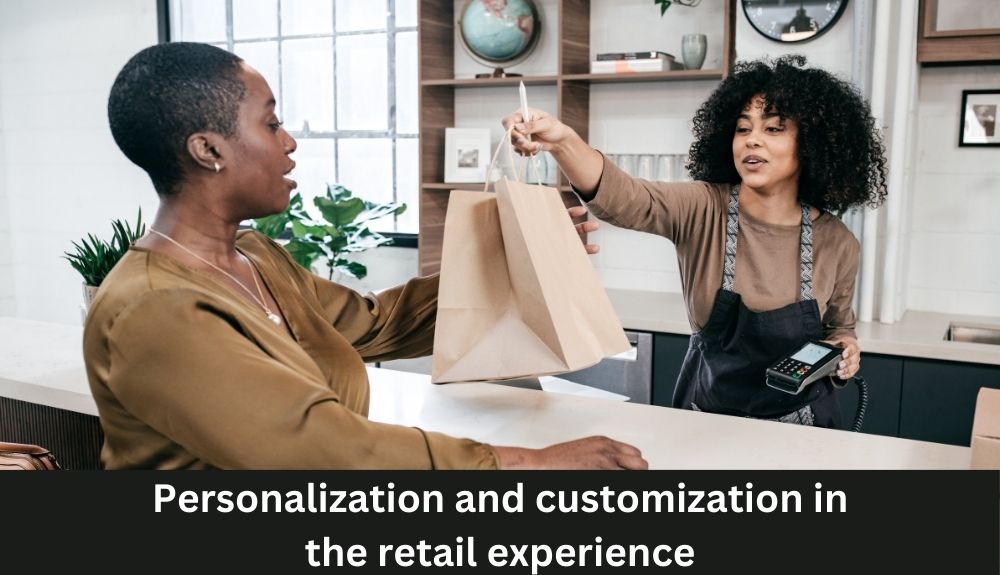Optimizing the Retail Experience: Creating Engaging Spaces and Seamless Shopping Journeys
Welcome to the exciting world of retail! In today’s fast-paced and ever-evolving market, creating an exceptional retail experience is more important than ever before. Gone are the days when customers simply walked into a store, picked up what they needed, and left. Modern consumers crave something more – an immersive journey that captivates their senses and leaves a lasting impression.
The retail landscape has undergone a remarkable transformation over the years, driven by changing customer expectations and advancements in technology. As retailers strive to stay competitive in this dynamic environment, it becomes crucial to optimize every aspect of the shopping experience.
In this blog post, we will explore how retailers can create engaging spaces and seamless shopping journeys that delight customers at every touchpoint. From innovative design concepts to personalized experiences powered by cutting-edge technology – we’ll uncover the key factors that contribute to a positive retail experience.
So buckle up as we embark on a thrilling adventure through the realms of modern retail design! Prepare yourself for insights, tips, and strategies that will help you elevate your business above the competition. Get ready to wow your customers with visually appealing spaces designed for engagement and technology-driven solutions that make their shopping journey smoother than ever before.
Let’s dive in!
The Evolution of Retail Design and Customer Expectations
The retail industry has undergone a dramatic transformation in recent years, with design playing a crucial role in meeting the changing expectations of customers. Gone are the days of crowded and cluttered stores; today’s consumers demand an experience that is both visually appealing and functional.
In the past, retail design focused primarily on creating a space where products could be displayed and sold. However, as customer expectations have evolved, so too has the approach to store design. Retailers now understand that every aspect of their store – from layout and lighting to signage and displays – contributes to the overall shopping experience.
One important trend in retail design is creating spaces that engage customers on an emotional level. By incorporating elements such as unique architectural features or interactive displays, retailers can create an environment that captivates shoppers’ attention and encourages them to spend more time exploring.
Another significant factor driving changes in retail design is technology. From self-checkout kiosks to virtual reality product demonstrations, technology has become an integral part of the modern shopping experience. By seamlessly integrating technology into their stores, retailers can enhance convenience for customers while also providing new opportunities for engagement.
Personalization is yet another key consideration when it comes to designing for today’s discerning shoppers. Customers expect a tailored experience that reflects their individual preferences and needs. This can involve anything from personalized product recommendations based on previous purchases to customizable options for items like clothing or home decor.
As customer expectations continue to evolve rapidly, it is essential for retailers to stay ahead of the curve by continuously adapting their designs and strategies accordingly. The future of successful retail lies in creating engaging spaces that not only meet but exceed customer expectations at every touchpoint along their shopping journey.
Factors that contribute to a positive retail experience
Creating a positive retail experience goes beyond just selling products. It involves understanding the needs and desires of customers and designing an environment that caters to their preferences. There are several factors that contribute to a positive retail experience:
1. Customer Service: Friendly, knowledgeable, and attentive staff can make all the difference in creating a welcoming atmosphere for shoppers. Customers appreciate when their questions are answered promptly and when they receive personalized recommendations.
2. Store Layout: A well-designed layout ensures that customers can easily navigate through the store, find what they need, and discover new products along the way. Clear signage, organized product displays, and strategic placement of merchandise create a seamless shopping journey.
3. Product Availability: Customers want assurance that the items they desire will be in stock when they visit your store. Implementing inventory management systems can help ensure adequate stock levels while also enabling efficient restocking processes.
4. Convenience: Offering convenient services such as click-and-collect or home delivery options can greatly enhance the overall shopping experience by saving customers time and effort.
5. Ambience: The ambience of a retail space plays a significant role in shaping customer perceptions and emotions during their shopping journey.
By carefully considering these factors – from excellent customer service to creating an inviting ambience – retailers can cultivate an environment where customers feel valued, engaged, and eager to return for future purchases.
Focusing on these aspects contributes to building long-lasting relationships with customers!
Designing for Engagement: Creating visually appealing spaces

When it comes to retail, creating visually appealing spaces is a crucial element in designing for engagement. Aesthetically pleasing environments have the power to captivate customers and keep them coming back for more. But what exactly makes a space visually appealing?
The use of color can greatly impact how customers perceive and engage with a retail space. Bold and vibrant colors can create excitement and draw attention, while softer tones can induce feelings of calmness and relaxation.
Another aspect to consider is lighting. Lighting plays a significant role in setting the mood of a store. Bright lighting can give off an energetic vibe, perfect for promoting activity and exploration. On the other hand, dimmer lighting can create an intimate atmosphere that encourages browsing at leisure.
In addition to color and lighting, strategic visual merchandising is essential in creating engaging spaces. Thoughtfully arranging products and displays not only enhances aesthetics but also helps guide customers through their shopping journey.
Moreover, incorporating unique design elements such as captivating signage or eye-catching focal points can further stimulate customer interest. These elements serve as conversation starters and provide opportunities for social media-worthy moments – something that today’s shoppers crave.
By designing visually appealing spaces that cater to customer preferences, retailers are able to enhance their overall brand experience while fostering deeper connections with their target audience.
In conclusion, Designing for engagement by creating visually appealing spaces requires careful consideration of factors like color palettes, lighting choices, visual merchandising techniques, as well as incorporating unique design elements. Retailers must strive to capture customers’ attention through captivating aesthetics that speak directly to their desires and preferences.
Implementing technology for a seamless shopping journey
With the rapid advancement of technology, retailers are finding innovative ways to enhance the shopping experience for their customers. Implementing cutting-edge technology has become crucial in creating a seamless and convenient journey for shoppers.
One way technology is being used is through the incorporation of mobile apps. These apps allow customers to browse products, check availability, and even make purchases directly from their smartphones. This eliminates the need for long queues at checkout counters and provides a more efficient shopping experience.
Another technological feature that enhances the retail journey is self-checkout kiosks. These kiosks enable customers to scan and pay for items themselves, reducing waiting times and providing an option for those who prefer self-service.
Virtual reality (VR) and augmented reality (AR) are also revolutionizing how consumers shop. VR allows customers to virtually try on clothing or test out furniture in their own homes before making a purchase decision. AR can be used in-store to provide additional information about products or create interactive experiences.
Additionally, retailers are utilizing data analytics to personalize customer experiences. By tracking individual preferences and purchasing behavior, they can offer tailored recommendations or discounts based on previous choices. This level of personalization not only makes shopping more enjoyable but also increases customer loyalty.
Implementing technology plays a vital role in creating a seamless shopping journey by streamlining processes, enhancing convenience, offering personalized experiences, and ultimately improving customer satisfaction. As retail continues to evolve alongside advancing technologies, it will be essential for businesses to stay up-to-date with these innovations in order to meet customer expectations effectively.
Personalization and customization in the retail experience

Personalization and customization have become buzzwords in the retail industry, and for good reason. Today’s consumers crave unique experiences that cater to their individual preferences and needs. Retailers who can provide personalized shopping journeys are more likely to attract and retain customers.
One way retailers are embracing personalization is by leveraging customer data. By collecting information about a shopper’s past purchases, browsing behavior, and preferences, retailers can tailor recommendations that align with their interests. This not only enhances the shopping experience but also increases the likelihood of conversion.
Another aspect of personalization is offering customized products or services. Many retailers now allow customers to personalize items such as clothing, accessories, or even furniture. This level of customization creates a sense of ownership and exclusivity for shoppers, making them feel valued by the brand.
In addition to product personalization, retailers are also focusing on creating personalized in-store experiences. For example, some stores use digital signage or interactive displays that can adapt based on a customer’s preferences or previous interactions with the brand. This allows for a more engaging and tailored experience within physical retail spaces.
Furthermore, technology plays a crucial role in enabling personalization at scale. With advancements in artificial intelligence (AI) and machine learning (ML), retailers can analyze vast amounts of data to anticipate customer needs accurately. This enables them to offer relevant recommendations both online and offline.
However, it’s essential for retailers not to rely solely on technology when it comes to personalization; human interaction still holds value. Well-trained staff who understand individual customer preferences can provide exceptional service that goes beyond what algorithms can achieve alone.
In conclusion, personalized experiences have become an expectation rather than just a nice-to-have feature in today’s retail landscape. By leveraging customer data, offering customizable products, and combining technology with human touchpoints, retailers can create memorable experiences that keep customers coming back for more. The key is continuously adapting strategies to meet evolving customer needs and staying ahead in the competitive retail market.
Conclusion: Importance of continuously evolving and adapting to meet customer needs
The retail industry is constantly evolving, and in order to stay relevant and successful, businesses must continuously adapt to meet the changing needs of their customers. Creating engaging spaces and seamless shopping journeys has become crucial in today’s competitive market.
By understanding the evolution of retail design and customer expectations, retailers can better cater to the desires of their target audience. Factors such as creating visually appealing spaces that are aesthetically pleasing and inviting can greatly enhance the overall shopping experience. Implementing technology solutions like digital signage, interactive displays, or contactless payment options can further streamline the process for customers.
Moreover, personalization and customization have become key elements in delivering a unique retail experience. By offering personalized recommendations based on past purchases or preferences, retailers can make customers feel valued and understood. Customized products or services also allow shoppers to create something that is uniquely theirs.
Optimizing the retail experience requires a multifaceted approach that integrates various elements like design aesthetics, technological advancements, personalization strategies, and more. The importance of continuously evolving and adapting cannot be overstated – it allows retailers to not only meet but exceed customer expectations. By staying ahead of trends and consistently seeking ways to improve the overall shopping journey for consumers, retailers will thrive in an increasingly competitive marketplace.











